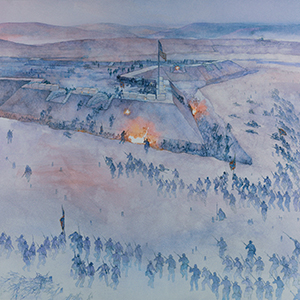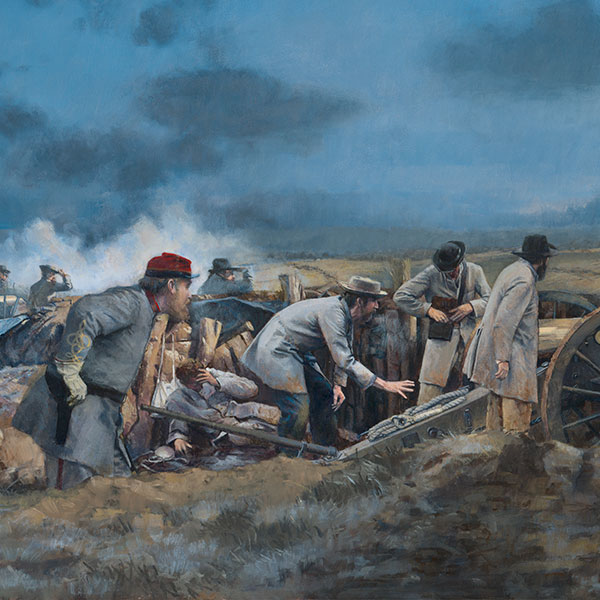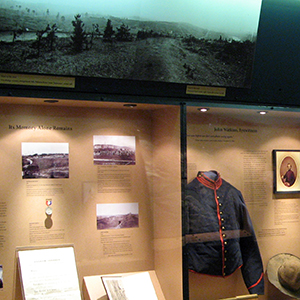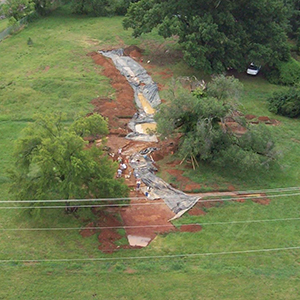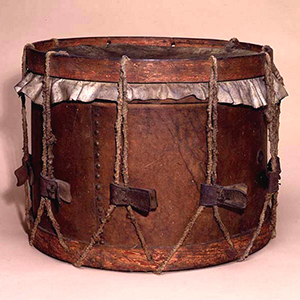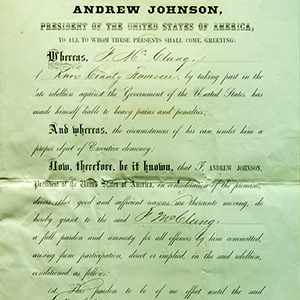The Civil War in Knoxville begins with an overview of the national political situation in the fall of 1863 and then focuses on the pivotal role of Knoxville’s Battle of Fort Sanders and East Tennessee during the American Civil War.
Original artifacts, both family heirlooms and archaeologically excavated items, as well as primary source documents, photographs, and video illustrate key elements of this historically significant time and place.
Explore the Digital Exhibition
The Knoxville Campaign
Knoxville is known for the Battle of Fort Sanders—a bloody and important battle fought on November 29, 1863, as part of the Knoxville Campaign of the Civil War. The Knoxville Campaign was a series of military encounters throughout the winter of 1863–64 as the initially uncontested federal occupation of East Tennessee was challenged by Confederate forces. The Confederacy could not afford the loss of the railroad that linked the Deep South with General Robert E. Lee’s army in Northern Virginia. Union forces under Major General Ambrose Burnside had occupied Knoxville in September; in November, a Confederate States Army under Lieutenant General James Longstreet moved north from Chattanooga in an effort to retake the city.
The exhibit is anchored by a 3D topographic recreation of an 1864 map of the defenses of Knoxville created by Captain Orlando Poe. Poe, General Burnside’s chief engineer, designed and executed the construction of fortifications and also oversaw detailed documentation of the Knoxville area. Knoxville features and locations discussed in the exhibit can be found and illuminated on the map.
Military Artifacts
Unique objects such as a drum found in Longstreet’s camp and Frank H. McClung’s authentic pardon signed by fellow Tennessean President Andrew Johnson, illustrate the range of material items that can survive to define an epoch.
Other items from important East Tennessee sites illustrate the multifaceted role the area played during the Civil War. Abraham Lincoln’s interest in the area is embodied in a walking stick carved for him out of wood from the site of Chattanooga’s Battle of Lookout Mountain by a veteran. Original 1863 copies of Harper’s Weekly and the New York Herald demonstrate how events in East Tennessee commanded front-page coverage.
Archaeological Excavations at Morgan Hill
Artifacts found at the important East Tennessee Civil War site of Morgan Hill are also highlighted in the exhibit. In the summer of 2009, UT’s Archaeological Research Laboratory conducted an excavation of the main 1863 Confederate artillery installation located west of Knoxville at Morgan Hill. The Civil War in Knoxville exhibit was fortunate to receive the artifacts retrieved from the work done at the only scientifically studied artillery position, Union or Confederate, from the siege of Knoxville. Mine balls, pottery, belt buckles, friction primers, and other significant items are on display.
Photography and the Civil War
While military artifacts comprise a large part of the exhibit, the newly developed technique of photographic portraiture at that time allows us a glimpse into the personalities of the many individuals, military and civilian, whose 1863 likenesses survive. One such portrait is that of John Watkins, an artillerist from Ohio who was inside Fort Sanders when the attack occurred. His letters home document the bloody horror from his own unique perspective, and his hat, jacket, and telescope substantiate the life of a simple man caught up in historic events.
Above the display cases are enlargements of panoramas taken by George Barnard, a well-known Civil War photographer. In March of 1864, Captain Poe, an early advocate of photography as a documentary tool, supervised a complete panoramic survey of the Knoxville area, making it one of the most thoroughly recorded sites of the Civil War.
Civil War Film
Knoxville film producer Steve Dean produced a 28-minute video to accompany the exhibit, entitled Its Memory Alone Remains. The film narrates the unique experience of East Tennessee during the Civil War. A full-size reproduction of the long gone Fort Sanders created for the film in a cow pasture in east Knox County now lives on and is used for reenactments, living history, and educational purposes.
Its Memory Alone Remains, the title taken from an 1890s Blue and Gray Reunion medal, employs live action, animation, dramatization, and historic documentation enhanced by unique contemporary footage acquired by flying low over Knoxville in a helicopter.
Civil War Paintings of the Battle of Fort Sanders
The exhibit also features two paintings that depict the Battle of Fort Sanders. At First Light, by artist Ken Smith, recreates the scene on the morning of November 29, 1863, when the Union fortifications were pounded by artillery from Confederate positions to the west and north of Knoxville, announcing the deadly assault commencing “at first light” at Fort Sanders.
Annapolis artist Greg Harlin spent two years researching and assembling all the historical sources—illustrations, photos, original letters and diaries, older paintings, and military diagrams—to create an accurate original painting of this Knoxville battle. The result is a hauntingly powerful rendering of fire and ice, the first light attack and slaughter that came to be known as the Battle of Fort Sanders.
Joan Markel, PhD, is an educator and archaeologist. She served as an educator, researcher and scholar specializing in Civil War history at the McClung Museum until her retirement in 2020. In 2013 she was honored with the “Teaching Excellence Award” from the East Tennessee History Center.
Markel joined the McClung Museum of Natural History and Culture at the University of Tennessee in 1995; in 2005 she became the Civil War Curator. She has a BA in anthropology from the University of Rochester, a Master of Library Science (MLS) from Indiana University, and an MA and Ph.D. in anthropology from the University at Buffalo.
The Markel family moved to Knoxville in 1990 from California, where she was employed in the online information industry. Once in Knoxville, she has taken an interest in local Civil War history, archaeology and in bringing museum resources and expertise to East Tennessee audiences. She is the author of Knoxville in the Civil War, published in 2013 for the Knoxville Civil War Sesquicentennial.

